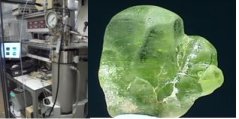Project
Autogenerative High Pressure Digestion

Motivation
Conventional anaerobic digestion is used to produce biogas (~65% CH4, ~30% CO2) from organic waste. leaving a waste sludge, which might be used as fertilizer. In the concept of Autogenerative High Pressure Digestion (AHPD), the methanogenic biomass builds up the pressure inside the reactor up to values of 20 bar. Because the solubility of CO2 increases more, relative to CH4 at higher pressure, the produced biogas in AHPD is of high quality (>90% CH4). This pressurized, high-quality biogas can be directly injected in a local natural gas distribution net. Moreover, the pressure might be used to drive membranes or pumps needed in the process. Acidification of the aqueous reactor phase by CO2 is prevented by CO2 immobilization with silicate minerals. In this way, the process delivers biogas which is ready for distribution, but also clean water and sludge with a possible use as fertilizer. We cooperate with Delft University and the company Bareau in this project.
Technological challenge
The technological challenge is to show that the overall AHPD concept works. This requires research on the following aspects:1) Anaerobic digestion in a pressurized reactor in which production of gaseous end products will build up to a pressure of 10-30 bar inside the system. With acetate as model substrate, we showed that a pressure of at least 20 bar is possible. AHPD with more complex substrates will also be studied
2) Modeling of the AHPD-process to quantify the effect of increasing pressure on solubility of CH4 and CO2, and its effect on pH. A first mathematical model has been made which will be compared with future experimental results. The model is then further refined.
3) Prevention of acidification(due to higher solubility of the weak acid CO2) of the AHPD-process by immobilization of CO2 with silicate minerals. First experiments showed that the biological conditions in the system enhance mineral carbonation of certain silicate mineral rocks, decrease the carbon dioxide content of the gas and buffer the pH, leaving carbonate rock as an end-product. The rate and efficiency of CO2 immobilization in various mineral rocks under AHPD conditions is further investigated.
4) Effect on microbiological population
Due to increased concentrations of CO2, CH4 and other gaseous intermediates (H2S, NH3 and H2) in the system, the Gibbs free energy of the involved conversions is altered. This indicates that different microbial degradation pathways might become possible. Furthermore, pressure tolerance of different micro-organisms involved in anaerobic digestion varies significantly. We are co-operating closely with the Laboratory of Microbiology to investigate this further.

CV researcher: Ralph Lindeboom
Graduated: Utrecht University, Innovation management (2006), Wageningen Universiteit, Environmental Technology (2008)
hobbies: travelling, percussion, martial arts
email: ralph.lindeboom@wur.nl
tel: 0317-483227